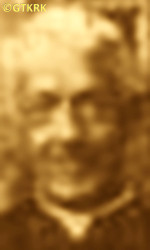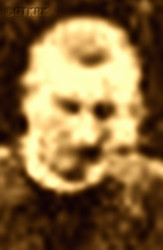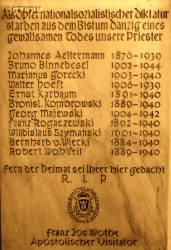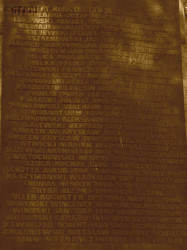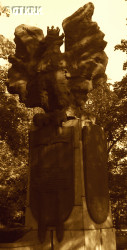Roman Catholic
St Sigismund parish
05-507 Słomczyn
85 Wiślana Str.
Konstancin deanery
Warsaw archdiocese, Poland
full list:
displayClick to display full list

searchClick to search full list by categories
wyświetlKliknij by wyświetlić pełną listę po polsku

szukajKliknij by przeszukać listę wg kategorii po polsku

Martyrology of the clergy — Poland
XX century (1914 – 1989)
personal data
surname
WOHLFEIL
forename(s)
Robert
function
diocesan priest
creed
Latin (Roman Catholic) Church RCmore on
en.wikipedia.org
[access: 2014.09.21]
diocese / province
Gdańsk diocesemore on
en.wikipedia.org
[access: 2017.01.21]
Apostolic Administration of Free City of Gdańskmore on
en.wikipedia.org
[access: 2017.01.21]
Culm (Chełmno) diocesemore on
pl.wikipedia.org
[access: 2012.11.23]
date and place
of death
12.06.1940

KL Sachsenhausenconcentration camp
today: Sachsenhausen‐Oranienburg, Oberhavel dist., Brandenburg state, Germany
more on
en.wikipedia.org
[access: 2018.11.18]
alt. dates and places
of death
13.06.1940
details of death
At the end of 1930s criticized often German Nazi authorities of the Free State of Gdańsk.
In 05.1937 for criticism expressed in a homily fined by Gdańsk court 1,000 Gdańsk guldens.
Thus after German invasion of Poland on 01.09.1939 (Russians invaded Poland 17 days later) and start of the World War II, after start of German occupation, arrested by the Germans already on 01.09.1939.
Jailed in Pruszcz Gdański school — turned by Germans into a temporary jail.
Beaten and tortured.
From there on c. 25.09.1939 (or earlier on 03‐04.09.1939) transported to ZL Neufahrwasser transit camp where was forced to slave at rubble removal from Westerplatte — place of heroic Polish defense in 09.1939.
Next on 11.02.1940 moved to KL Stutthof concentration camp.
Repeatedly refused to sign Volksliste — a list of German nationals — what could lead to release from camp.
Finally on 09‐10.04.1940 transported to KL Sachsenhausen concentration camp where he was tortured and finished of by a camp kapo, Fritz — prob. thrown out of the roof while working at covering it with tar.
According to the death certificate in the books of the Germ. Standesamt (Eng. registry office) in Oranienburg, No. 2968/40, the „honest” otherwise German „medical doctors” and formalists — and at the same time, unrivaled fairy tale spinners — noted that the cause of death was Germ. „Bauchfellentzündung nach Blinddarmentzündung” (Eng. „Peritonitis after appendicitis”).
prisoner camp's numbers
23398Click to display source page (KL SachsenhausenClick to display the description), 5816Click to display source page (KL StutthofClick to display the description)
cause of death
murder
perpetrators
Germans
sites and events
KL SachsenhausenClick to display the description, KL StutthofClick to display the description, ZL NeufahrwasserClick to display the description, «Intelligenzaktion»Click to display the description, Reichsgau Danzig‐WestpreußenClick to display the description, Ribbentrop‐MolotovClick to display the description, Pius XI's encyclicalsClick to display the description
date and place
of birth
08.01.1889

Suminpart known as Kuczwały
today: Biskupiec gm., Nowe Miasto Lubawskie pov., Warmia‐Masuria voiv., Poland
more on
en.wikipedia.org
[access: 2021.09.02]
alt. dates and places
of birth
Podlasektoday: Biskupiec gm., Nowe Miasto Lubawskie pov., Warmia‐Masuria voiv., Poland
more on
en.wikipedia.org
[access: 2022.01.28]
Kuczwałytoday: Chełmża gm., Toruń pov., Kuyavia‐Pomerania voiv., Poland
more on
en.wikipedia.org
[access: 2021.12.18]
Koniecwałdtoday: Sztum gm., Sztum pov., Pomerania voiv., Poland
more on
en.wikipedia.org
[access: 2022.01.28]
parents
WOHLFEIL Herman
🞲 ?, ? — 🕆 ?, ?

MURAWSKA Mary
🞲 ?, ? — 🕆 ?, ?
presbyter (holy orders)
ordination
11.02.1917

positions held
1932 – 1939
parish priest — Kłodawatoday: Trąbki Wielkie gm., Gdańsk pov., Pomerania voiv., Poland
more on
en.wikipedia.org
[access: 2021.12.18] ⋄ St James RC parish ⋄ Gdańsk‐countrysidedeanery name
today: Pomerania voiv., Poland RC deanery
vicar — Sopottoday: Sopot city pov., Pomerania voiv., Poland
more on
en.wikipedia.org
[access: 2022.01.28] ⋄ Blessed Virgin Mary of the Assumption – Star of the Sea RC parish
1929 – 1931
vicar — GdańskNowy Port district
today: Gdańsk city pov., Pomerania voiv., Poland
more on
en.wikipedia.org
[access: 2021.12.18] ⋄ St Hedwig of Silesia RC parish ⋄ Gdańsk / Gdańsk IIdeanery names/seats
today: Pomerania voiv., Poland RC deanery
vicar — GdańskŚródmieście district
today: Gdańsk city pov., Pomerania voiv., Poland
more on
en.wikipedia.org
[access: 2022.02.24] ⋄ St Joseph RC parish
vicar — Grudziądztoday: Grudziądz city pov., Kuyavia‐Pomerania voiv., Poland
more on
en.wikipedia.org
[access: 2021.09.02] ⋄ St Nicholas the Bishop and Confessor RC parish (main parish)
vicar — Złotowotoday: Lubawa gm., Iława pov., Warmia‐Masuria voiv., Poland
more on
en.wikipedia.org
[access: 2021.12.18] ⋄ St Barbara the Virgin and Martyr RC curacy
vicar — Grucznotoday: Świecie gm., Świecie pov., Kuyavia‐Pomerania voiv., Poland
more on
en.wikipedia.org
[access: 2022.02.24] ⋄ St John the Baptist RC parish ⋄ Świecietoday: Świecie gm., Świecie pov., Kuyavia‐Pomerania voiv., Poland
more on
en.wikipedia.org
[access: 2021.09.02] RC deanery
1914 – 1917
student — Pelplintoday: Pelplin gm., Tczew pov., Pomerania voiv., Poland
more on
en.wikipedia.org
[access: 2021.05.06] ⋄ philosophy and theology, Theological Seminary
1913 – 1914
student — Freiburg im Breisgautoday: Freiburg im Breisgau urban dist., Freiburg reg., Baden‐Württemberg state, Germany
more on
en.wikipedia.org
[access: 2020.07.31] ⋄ philosophy and theology, Albrecht and Louis University — scholarship holder of the Society for Scientific Assistance
1912 – 1913
student — Pelplintoday: Pelplin gm., Tczew pov., Pomerania voiv., Poland
more on
en.wikipedia.org
[access: 2021.05.06] ⋄ philosophy and theology, Theological Seminary
others related
in death
AELTERMANNClick to display biography John Paul, BINNEBESELClick to display biography Bruno, GÓRECKIClick to display biography Marian, HOEFTClick to display biography Walter Joseph, KOMOROWSKIClick to display biography Bronislav Boleslav, MAJEWSKIClick to display biography George Alphonse, ROGACZEWSKIClick to display biography Francis Xavier, SZYMAŃSKIClick to display biography Vladislav, WIECKIClick to display biography Bernard Anthony
sites and events
descriptions
KL Sachsenhausen: In Germ. Konzentrationslager (Eng. concentration camp) KL Sachsenhausen, set up in the former Olympic village in 07.1936, hundreds of Polish priests were held in 1940, before being transported to KL Dachau. Some of them perished in KL Sachsenhausen. Murderous medical experiments on prisoners were carried out in the camp. In 1942‐1944 c. 140 prisoners slaved at manufacturing false British pounds, passports, visas, stamps and other documents. Other prisoners also had to do slave work, for Heinkel aircraft manufacturer, AEG and Siemens among others. On average c. 50,000 prisoners were held at any time. Altogether more than 200,000 inmates were in jailed in KL Sachsenhausen and its branched, out of which tens of thousands perished. Prior to Russian arrival mass evacuation was ordered by the Germans and c. 80,000 prisoners were marched west in so‐called „death marches” to other camps, i.e. KL Mauthausen‐Gusen and KL Bergen‐Belsen. The camp got liberated on 22.04.1945. After end of armed hostilities Germans set up there secret camp for German prisoners and „suspicious” Russian soldiers. (more on: en.wikipedia.orgClick to attempt to display webpage
[access: 2018.11.18])
KL Stutthof: In German Germ. Konzentrationslager (Eng. concentration camp) KL Stutthof (then in Eastern Prussian belonging to Germany, today: Sztutowo village) concentration camp, that Germans started to build on 02.09.1939, a day after German invasion of Poland and start of the World War II, Germans held c. 110,000‐127,000 prisoners from 28 countries, including 49,000 women and children. C. 65,000 victims were murdered and exterminated. In the period of 25.01‐27.04.1945 in the face of approaching Russian army Germans evacuated the camp. When on 09.05.1945 Russians soldiers entered the camp only 100 prisoners were still there. In an initial period (1939‐1940) Polish Catholic priests from Pomerania were held captive there before being transported to KL Dachau concentration camp. Some of them were murdered in KL Stutthof or vicinity (for instance in Stegna forest). Also later some Catholic priests were held in KL Stutthof. (more on: stutthof.orgClick to attempt to display webpage
[access: 2018.11.18], en.wikipedia.orgClick to attempt to display webpage
[access: 2013.07.06])
ZL Neufahrwasser: Germ. Zivilgefangenenlager (Eng. POW camp for civilians) organized by the Germans on the day of the outbreak of the war, on 01.09. 1939, in Gdańsk ‐ Nowy Port (New Port), in former artillery barracks belonging to Poland, for Poles from Pomerania arrested as part of the «Intelligenzaktion» action — extermination of Polish intelligentsia. Prisoners from ZL Neufahrwasser — 2,702 people were identified, but it is estimated that c. 10,000 arrestees passed through the camp — were sent to the KL Stutthof concentration camp or directly to the places of extermination. The camp operated till 01.04.1940 (more on: stutthof.orgClick to attempt to display webpage
[access: 2013.08.10], ofiaromwojny.republika.plClick to attempt to display webpage
[access: 2013.12.04])
«Intelligenzaktion»: German: «Intelligenzaktion» (English: „Intelligence Action”) — a German program of extermination of the Polish elite, mainly the intelligentsia and leadership layers, carried out from the beginning of the occupation in w 09.1939 to 04.1940, mainly in territories directly annexed to Germany, but also in the so‐called Germ. Generalgouvernement (Eng. General Governorate), where it was called «AB‐aktion». In the first phase, immediately after the beginning of the German occupation, during military operations carried out by the Germ. Wehrmacht (Eng. Armed Forces) and the genocidal units of the Germ. Einsatzgruppen (Eng. Operational Groups) of the Germ. Sicherheitspolizei (Eng. Security Police), i.e. SiPo, and Germ. Sicherheitsdienst des Reichsführers SS (Eng. Security Service of the Reichsführer SS), i.e. SD, organized by the Germ. Reichssicherheitshauptamt (Eng. Reich Main Security Office), i.e. RSHA, which followed the troops, carried out under the Germ. Unternehmen „Tannenberg” (Eng. Operation „Tannenberg”) — based on the so‐called Germ. Sonderfahndungsliste (Eng. Special Wanted Lists), i.e. proscription lists of Poles considered particularly dangerous to the Third Reich, prepared by the Zentralstelle II/P (Polen) unit of the German RSHA. Later, implemented by the German civilian occupation authorities and the genocidal unit of the Germ. Volksdeutscher Selbstschutz (Eng. Ethnic Germans Self‐Defense), whose members were Germ. Volksdeutsche (Eng. Ethnic Germans), i.e. representatives of the German minority in Poland. According to various sources, these lists, at the beginning of 09.1939, could have contained the details of 61,000—88,000 „dangerous” Poles — although these figures cannot be confirmed. In total, during this genocide, c. 50,000 teachers, Catholic priests, representatives of the landed gentry, freelancers, social and political activists, and retired military personnel were systematically and methodically murdered. Another 50,000 were sent to concentration camps, where only a negligible percentage survived. (more on: en.wikipedia.orgClick to attempt to display webpage
[access: 2014.10.04])
Reichsgau Danzig‐Westpreußen: After the Polish defeat in the 09.1939 campaign, which was the result of the Ribbentrop‐Molotov Pact and constituted the first stage of World War II, and the beginning of German occupation in part of Poland (in the other, eastern part of Poland, the Russian occupation began), the Germans divided the occupied Polish territory into five main regions (and a few smaller). The largest one was transformed into Germ. Generalgouvernement (Eng. General Governorate), intended exclusively for Poles and Jews and constituting part of the so‐called Germ. Großdeutschland (Eng. Greater Germany). Two were added to existing German provinces. From two other separate new provinces were created. Vistula Pomerania region was one of them, incorporated into Germany on 08.10.1939, by decree of the German leader Adolf Hitler (formally came into force on 26.10.1939), and on 02.11.1939 transformed into the Germ. Reichsgau Danzig‐Westpreußen (Eng. Reich District of Gdańsk‐West Prussia) province, in which the law of the German state was to apply. The main axis of the policy of the new province, the territory of which the Germans recognized as the Germ. „Ursprünglich Deutsche” (Eng. „natively German”), despite the fact that 85% of its inhabitants were Poles, was Germ. „Entpolonisierung” (Eng. „Depolonisation”), i.e. forced Germanization. C. 60,000 Poles were murdered in 1939‐1940, as part of the Germ. „Intelligenzaktion”, i.e. extermination of Polish intelligentsia and ruling classes, in c. 432 places of mass executions — including c. 220 Polish Catholic priests. The same number were sent to German concentration camps, from where few returned (over 300 priests were arrested, of whom c. 130 died in concentration camps). C. 124,000‐170,000 were displaced, including c. 90,000 to the Germ. Generalgouvernement. Poles were forced en masse to sign the German nationality list, the Germ. Deutsche Volksliste DVL. Polish children could only learn in German. It was forbidden to use the Polish language during Catholic Holy Masses and during confession. Polish landed estates were confiscated..To further reduce the number of the Polish population, Poles were sent to forced labor deep inside Germany. The remaining Poles were treated as low‐skilled labor, isolated from the Germans and strictly controlled — legally, three or three of them could only meet together, even in their own apartments. Many were conscripted into the German Wehrmacht army. After the end of hostilities of World War II, the overseer of this province, the Germ. Reichsstatthalter (Eng. Reich Governor) and the Germ. Gauleiter (Eng. district head) of the German National Socialist Party, Albert Maria Forster, was executed. (more on: en.wikipedia.orgClick to attempt to display webpage
[access: 2024.06.24])
Ribbentrop‐Molotov: Genocidal Russian‐German alliance pact between Russian leader Joseph Stalin and German leader Adolf Hitler signed on 23.08.1939 in Moscow by respective foreign ministers, Mr. Vyacheslav Molotov for Russia and Joachim von Ribbentrop for Germany. The pact sanctioned and was the direct cause of joint Russian and German invasion of Poland and the outbreak of the World War II in 09.1939. In a political sense, the pact was an attempt to restore the status quo ante before 1914, with one exception, namely the „commercial” exchange of the so‐called „Kingdom of Poland”, which in 1914 was part of the Russian Empire, fore Eastern Galicia (today's western Ukraine), in 1914 belonging to the Austro‐Hungarian Empire. Galicia, including Lviv, was to be taken over by the Russians, the „Kingdom of Poland” — under the name of the General Governorate — Germany. The resultant „war was one of the greatest calamities and dramas of humanity in history, for two atheistic and anti‐Christian ideologies — national and international socialism — rejected God and His fifth Decalogue commandment: Thou shall not kill!” (Abp Stanislav Gądecki, 01.09.2019). The decisions taken — backed up by the betrayal of the formal allies of Poland, France and Germany, which on 12.09.1939, at a joint conference in Abbeville, decided not to provide aid to attacked Poland and not to take military action against Germany (a clear breach of treaty obligations with Poland) — were on 28.09.1939 slightly altered and made more precise when a treaty on „German‐Russian boundaries and friendship” was agreed by the same murderous signatories. One of its findings was establishment of spheres of influence in Central and Eastern Europe and in consequence IV partition of Poland. In one of its secret annexes agreed, that: „the Signatories will not tolerate on its respective territories any Polish propaganda that affects the territory of the other Side. On their respective territories they will suppress all such propaganda and inform each other of the measures taken to accomplish it”. The agreements resulted in a series of meeting between two genocidal organization representing both sides — German Gestapo and Russian NKVD when coordination of efforts to exterminate Polish intelligentsia and Polish leading classes (in Germany called «Intelligenzaktion», in Russia took the form of Katyń massacres) where discussed. Resulted in deaths of hundreds of thousands of Polish intelligentsia, including thousands of priests presented here, and tens of millions of ordinary people,. The results of this Russian‐German pact lasted till 1989 and are still in evidence even today. (more on: en.wikipedia.orgClick to attempt to display webpage
[access: 2015.09.30])
Pius XI's encyclicals: Facing the creation of two totalitarian systems in Europe, which seemed to compete with each other, though there were more similarities than contradictions between them, Pope Pius XI issued in 03.1937 (within 5 days) two encyclicals. In the „Mit brennender Sorge” (Eng. „With Burning Concern”) published on 14.03.1938, condemned the national socialism prevailing in Germany. The Pope wrote: „Whoever, following the old Germanic‐pre‐Christian beliefs, puts various impersonal fate in the place of a personal God, denies the wisdom of God and Providence […], whoever exalts earthly values: race or nation, or state, or state system, representatives of state power or other fundamental values of human society, […] and makes them the highest standard of all values, including religious ones, and idolizes them, this one […] is far from true faith in God and from a worldview corresponding to such faith”. On 19.03.1937, published „Divini Redemptoris” (Eng. „Divine Redeemer”), in which criticized Russian communism, dialectical materialism and the class struggle theory. The Pope wrote: „Communism deprives man of freedom, and therefore the spiritual basis of all life norms. It deprives the human person of all his dignity and any moral support with which he could resist the onslaught of blind passions […] This is the new gospel that Bolshevik and godless communism preaches as a message of salvation and redemption of humanity”… Pius XI demanded that the established human law be subjected to the natural law of God , recommended the implementation of the ideal of a Christian state and society, and called on Catholics to resist. Two years later, National Socialist Germany and Communist Russia came together and started World War II. (more on: www.vatican.vaClick to attempt to display webpage
[access: 2023.05.28], www.vatican.vaClick to attempt to display webpage
[access: 2023.05.28])
sources
personal:
www.stutthof.plClick to attempt to display webpage
[access: 2012.11.23], pl.wikipedia.orgClick to attempt to display webpage
[access: 2013.02.09], www.gosc.plClick to attempt to display webpage
[access: 2018.11.18]
bibliographical:
„Biographical dictionary of priests of the Chełmno diocese ordained in the years 1821‐1920”, Henry Mross, Pelplin, 1995
„International Tracing Service (ITS), Bad Arolsen, GermanyClick to display source page”, Arolsen Archives
original images:
www.facebook.comClick to attempt to display webpage
[access: 2024.01.19], strefahistorii.plClick to attempt to display webpage
[access: 2018.02.15], de.wikipedia.orgClick to attempt to display webpage
[access: 2015.04.18], www.panoramio.comClick to attempt to display webpage
[access: 2015.04.18], www.panoramio.comClick to attempt to display webpage
[access: 2015.04.18]
LETTER to CUSTODIAN/ADMINISTRATOR
If you have an Email client on your communicator/computer — such as Mozilla Thunderbird, Windows Mail or Microsoft Outlook, described at WikipediaPatrz:
en.wikipedia.org, among others — try the link below, please:
LETTER to CUSTODIAN/ADMINISTRATORClick and try to call your own Email client
If however you do not run such a client or the above link is not active please send an email to the Custodian/Administrator using your account — in your customary email/correspondence engine — at the following address:

giving the following as the subject:
MARTYROLOGY: WOHLFEIL Robert
To return to the biography press below:
 Click to return to biography
Click to return to biography








